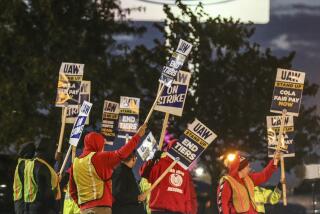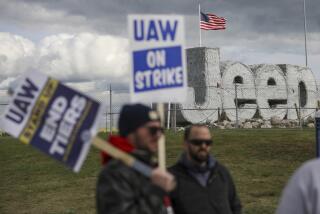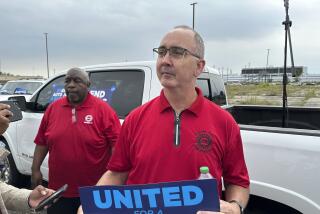Town faces hazy future after exit of auto plant
- Share via
LORAIN, OHIO — When Mary Porter arrived here in the 1950s, she and her family were drawn to this prosperous stretch of northeastern Ohio, where miles of industrial smokestacks and brick factories are a short drive from quiet neighborhoods of wooden American Foursquare homes and plentiful rose gardens.
It was a time and a town of such plenty, she said, “you only had to be able to breathe to get a good-paying job.”
For 30 years, her husband, Glen, worked on the line at the Ford Motor Co. assembly plant. But by December 2005, when Ford shut down the plant, most of the factories in Lorain -- once a thriving center for steel, auto parts and shipbuilding -- already sat empty.
More than two decades after hard times hit American manufacturing, this city of nearly 68,000 is developing into more than a simple economic cautionary tale. Lorain -- located about 30 miles west of Cleveland -- has become an example of how life perseveres in a dying town.
“We’ve spent years learning how to do with less, have less, be less,” said Porter, 75, who relies on her now-deceased husband’s auto pension.
“What’s bad about tightening your belt?” Lorain Mayor Craig Foltin said. “We’re making the most of what we have.”
Since May 2005, the domestic auto industry has eliminated or proposed cutting 132,000 manufacturing jobs and the Big Three -- Ford, General Motors Corp. and Chrysler Group -- have outlined plans to eliminate at least 100,000 more manufacturing and salaried jobs in the U.S. and Canada by 2009. The vast majority of the cuts have been in the Midwest, with Michigan leading the pack and Ohio coming in second.
In addition to the Ford closure in Lorain, there are more losses ahead in this part of Ohio. Chrysler, a unit of DaimlerChrysler, plans to cut jobs in Streetsboro and Twinsburg over the next few years. General Motors cut 770 jobs at an assembly plant in Lordstown. Ford plans to close a stamping plant in Maumee with 680 employees and to either sell or close a 1,700-worker plant near Sandusky.
According to the nonprofit Center for Automotive Research in Ann Arbor, Mich., the elimination of one automaking job causes the loss of four jobs in related industries.
What’s happening in Lorain, economists and regional lawmakers say, could offer a glimpse into what similar communities across the country can expect in the years to come.
Another factor that could change the region’s future: Billionaire investor Kirk Kerkorian, who lost a bid to buy Chrysler in the late 1990s when it instead merged with Daimler-Benz, has made a $4.5-billion all-cash offer to buy the automaker from its German parent company.
“Any city that has some assets should be able to reinvent itself -- even if it’s only as a small town,” said Ziona Austrian, director of the Center for Economic Development at Cleveland State University.
“The question towns like Lorain have to ask themselves is this: How low and how far do you have to go before you fi- nally reach equilibrium, and will someone from the outside come in to save them?”
The relationship between Lorain and factories is as long as the miles of potholed streets that now crisscross the city.
First settled in the early 1800s, Lorain began to draw manufacturers by the end of that century, lured by the town’s port and railroad station for use in transporting goods across the country. The first factory was Lorain Brass Works, which employed 600 people to make plumbing fixtures and pipes.
“After that, the ship builders came. The steel mills followed, and so did the people,” said John McGarvey, chairman of the board of trustees for the Black River Historical Society.
Soon after Ford built its massive plant on the west side of town in 1958, families of Ford employees filled entire neighborhoods, where children played on sidewalks lined with oak and elm trees, and driveways were filled with the latest domestic models.
John Wargo fondly remembers how his job as an electrician, fixing the equipment on the assembly line, placed him at the top of Lorain’s blue-collar social strata.
“You’d walk into town and people would know you were with Ford,” said Wargo, 70. “You could go downtown and get into any restaurant. Shops knew we made good money, so they were always happy to see you.”
The plant had felt the bite of earlier industry downturns, said Wargo, with workers seeing less access to overtime and some hiring freezes. But things really turned in the 1990s, when Ford pulled car lines away from Lorain and shipped the work to plants in Mexico and elsewhere.
“Each time, we’d lose more people,” Wargo said. “By the time the plant closed in 2005, there were already so many empty buildings at the plant, it was like walking through a ghost town.”
About half of the jobs were transferred to an assembly plant in nearby Avon Lake. The rest of the workers either took buyout offers or, like Wargo, retired.
Even before the Ford plant closed, the economic trickle-down effect was already being felt across town, said Ted Kalo, a Lorain County commissioner.
The number of orthodontists in town dwindled to two. Furniture shops closed, as did clothing boutiques, hair salons and day spas. Kalo said his family’s carpet and flooring business watched its sales fall by half as residents scaled back on home-improvement projects.
In a town whose official moniker is the International City, residents said it used to be no big deal to get Thai food. Now you have to drive nearly 10 miles to Elyria, Ohio. Sushi? Indian? Get in the car and head to Cleveland.
More than half of the two-story brick storefronts along the city’s downtown stretch of Broadway Avenue sit abandoned and boarded up. A florist across the street from Kalo’s shop left three months ago.
“Even a single rose is a luxury most people won’t splurge on these days,” Kalo said. “I’m starting to get calls from Little League coaches, begging me to sponsor another team.”
Over time, the cuts extended beyond the comforts of life and dipped deeper into the fabric of the town. Park fields became overgrown as the city scaled back how frequently it could afford to cut the grass. Several of the town’s churches are talking about consolidating their services to cut costs and deal with dropping attendance.
A Catholic high school was shuttered in 2004 because of waning enrollment. A “for sale” sign was posted near the front office, but the campus hasn’t sold and the words have faded.
Wargo watches the decay’s slow progress each month when he meets with fellow retirees across the street from the plant at the United Auto Workers’ former union hall. The local closed and the UAW sold the building last year. The current owners still let the auto retirees use the union hall for their monthly gathering for benefit updates.
“Everyone’s cutting back,” Wargo said.
But cutting back doesn’t mean not living. For people such as Porter, it simply means a more austere life. She could leave town, perhaps move out of the family farmhouse on the south side of town and into a condominium in Cleveland. But that would mean leaving her daughter and grandchild behind -- if she could even find someone to buy the property.
So she stays and focuses on the good things in town. “It’s a quiet place to live,” Porter said. “The people are still friendly. Spring’s coming, which means the weather’s warming up and there won’t be any more snow to shovel.”
City officials hope that in its postindustrial years Lorain can become another bedroom community for Cleveland or a site for light manufacturing or business development. Real estate developers have turned the west side of town into the “new” Lorain, with high-end homes aimed at wealthy investors.
Some of the old shipyard buildings have been converted into hip lofts and condos, which have slowly been picked up by young professionals willing to make the 30-mile commute in exchange for relatively cheap housing -- from $160,000 to $300,000 for homes with waterfront views.
Foltin touts one of the city’s key selling points: tons of available land for entrepreneurs to develop their businesses.
Take the old Ford plant. Ford recently sold the 276-acre site to a California industrial realty group -- and a local developer is promising to bring in hundreds of light-assembly jobs on the site.
The jobs are expected to pay $8 to $14 an hour, or a third to half of what a union auto worker’s job would pay.
“Some jobs are better than no jobs,” Foltin insisted. “We’ll take whatever successes we can get.”
The mayor, however, will be gone before the hiring begins. He’s leaving his City Hall position at the end of this year to use his accounting degree in the private sector.
Last month, Foltin sat at his office desk, calling sources and friends to break the news of his departure -- and see if anyone knew where he could send a copy of his resume.
“I’m willing to leave town,” Foltin told one caller. But, he noted, “I don’t want to.”
Times staff writer John O’Dell contributed to this report.






